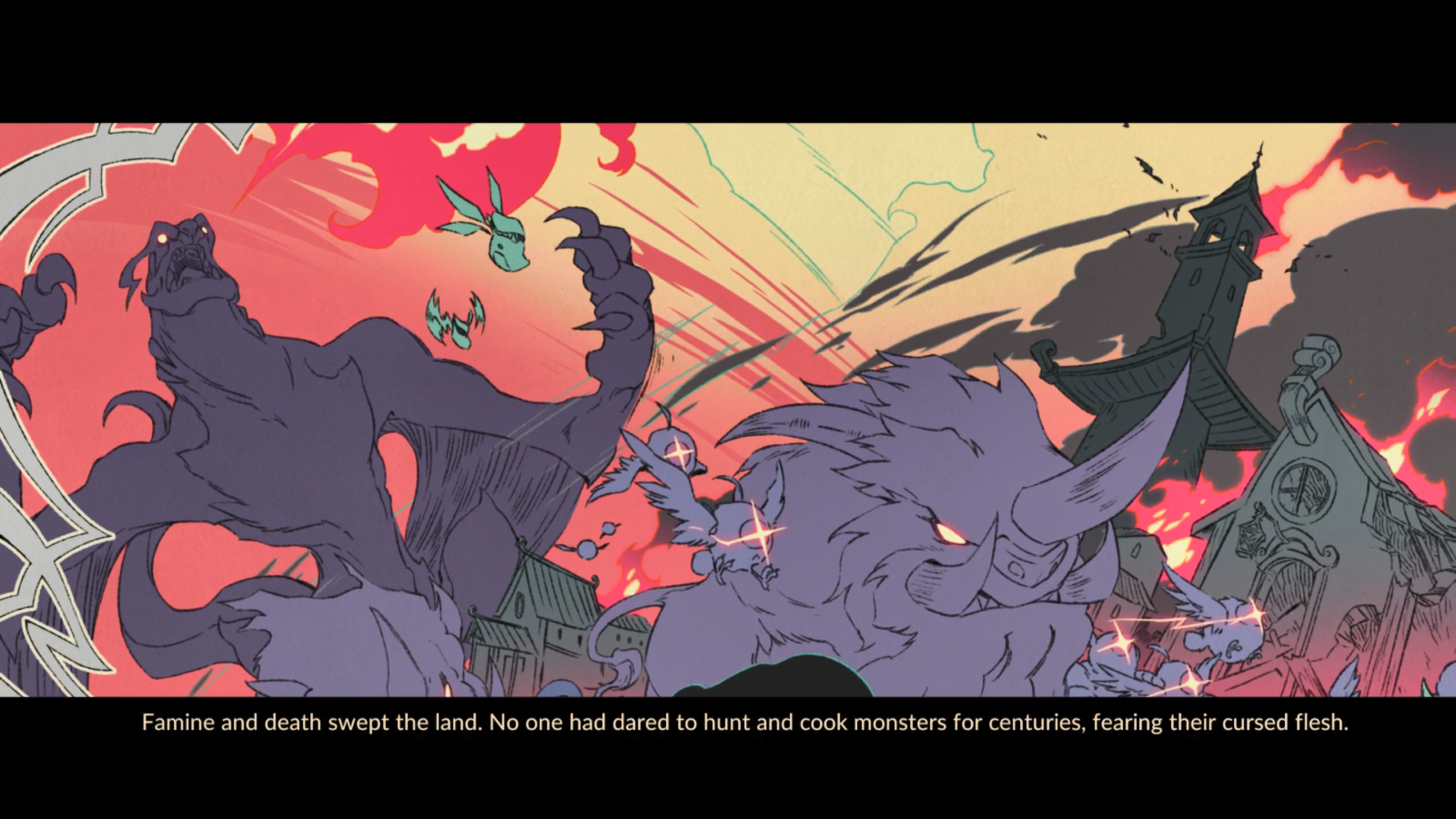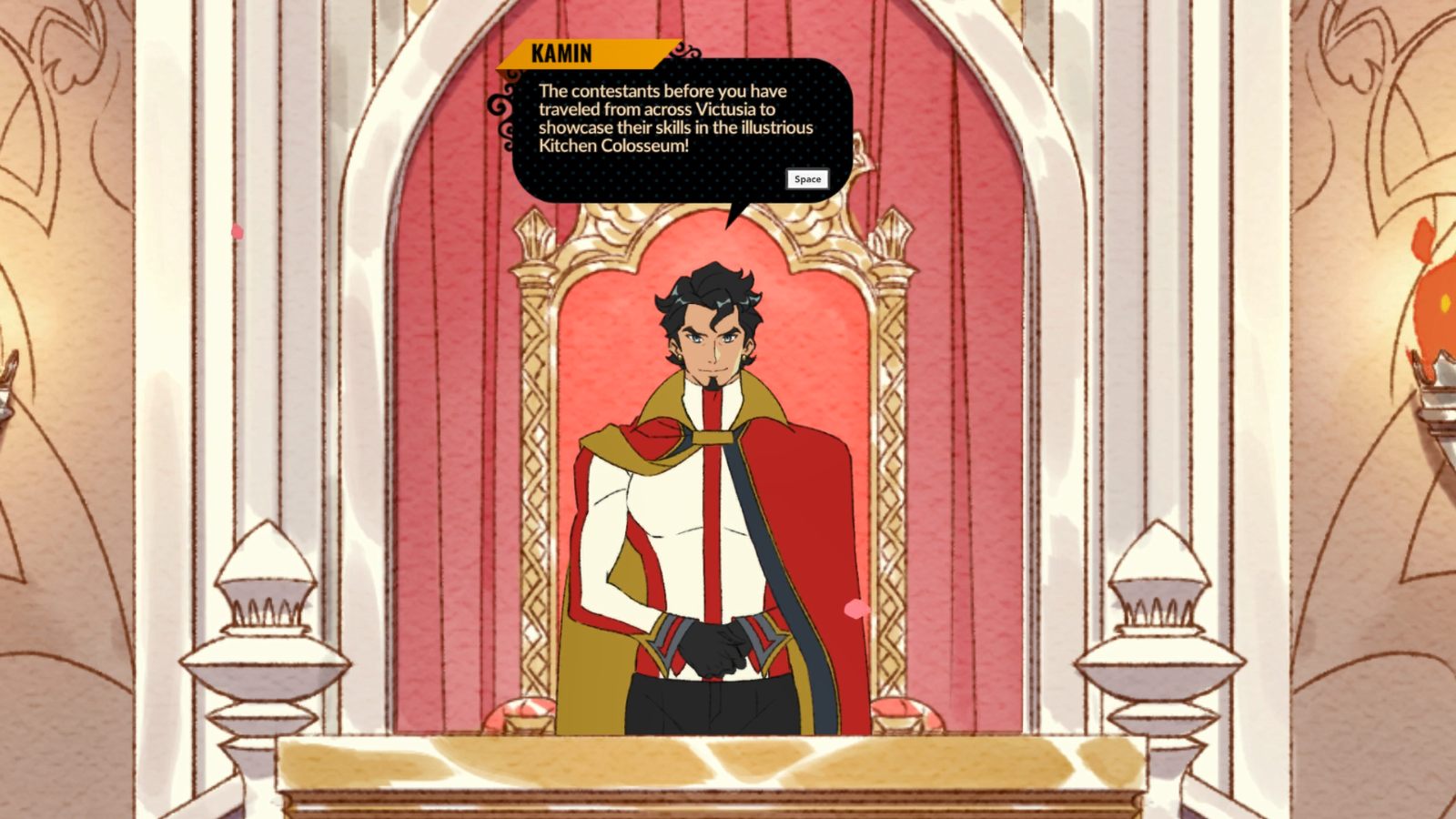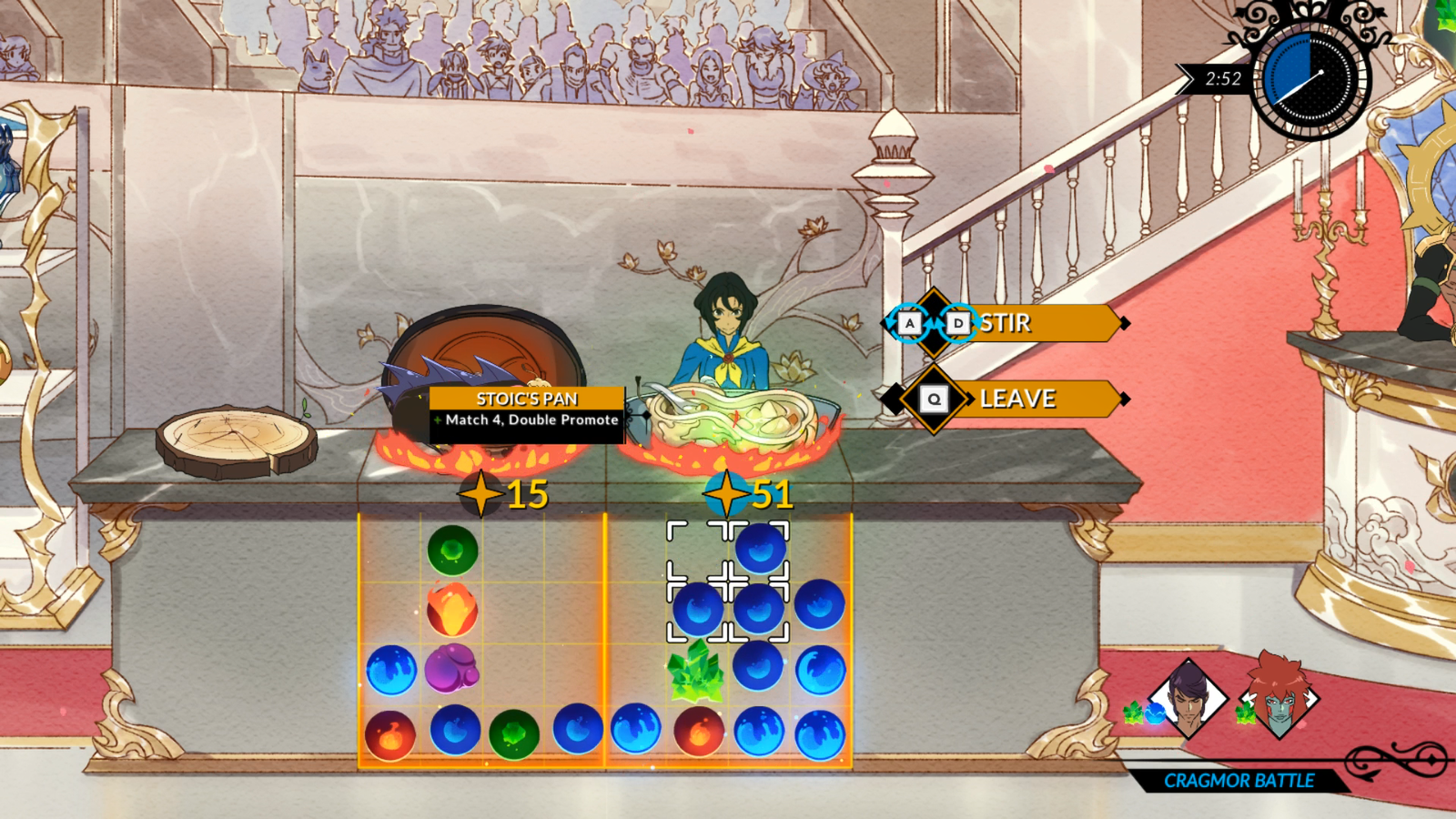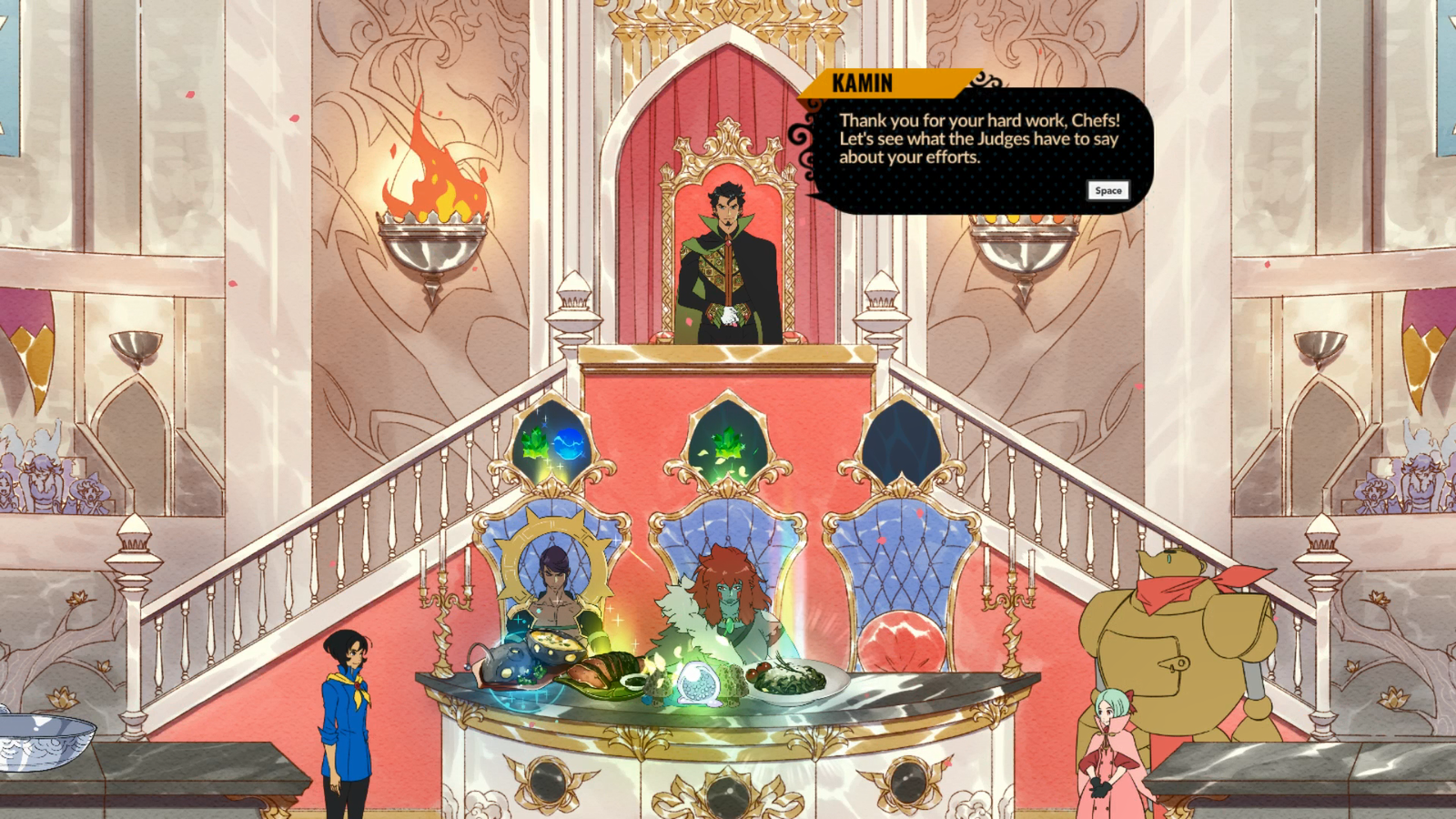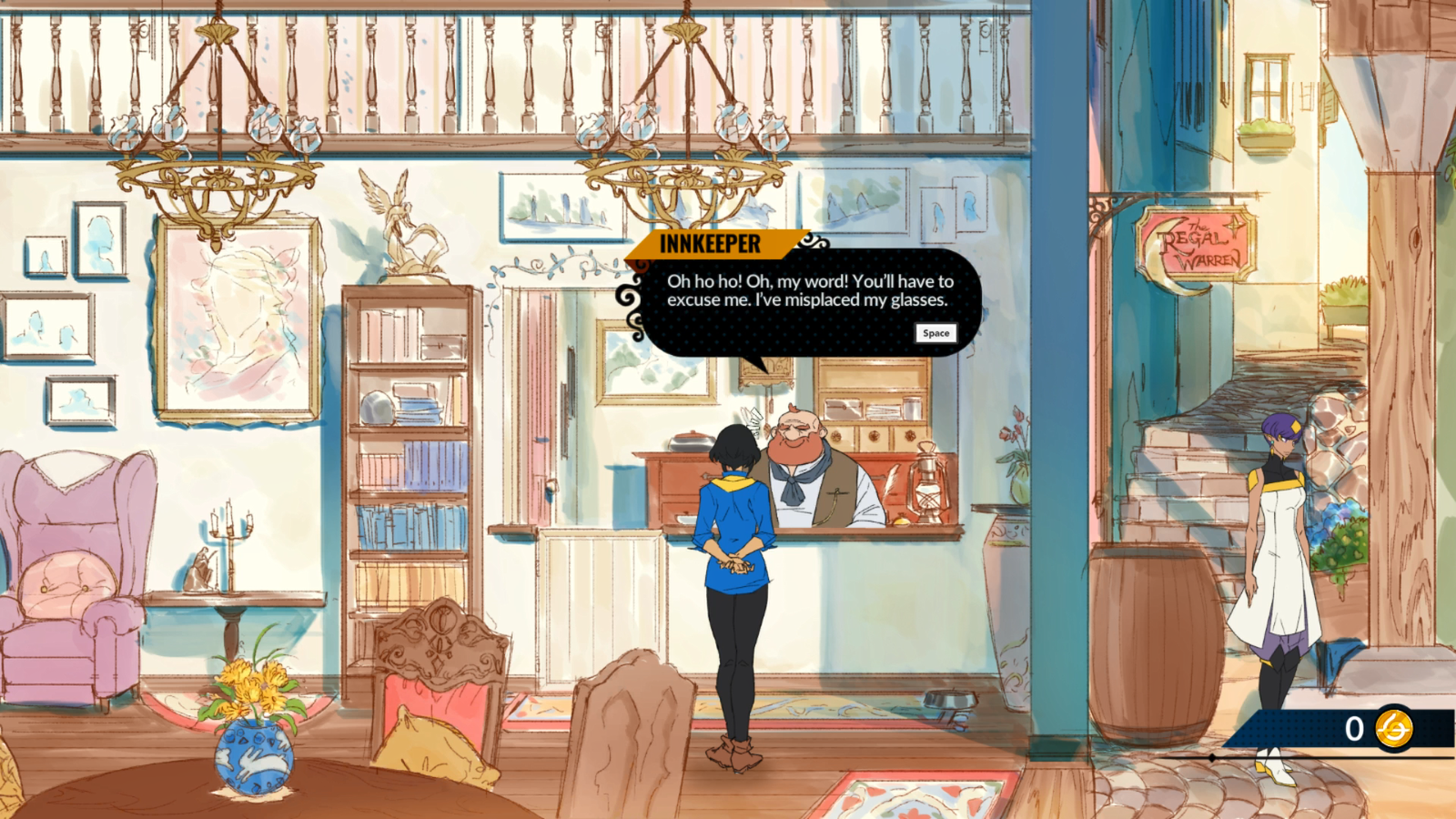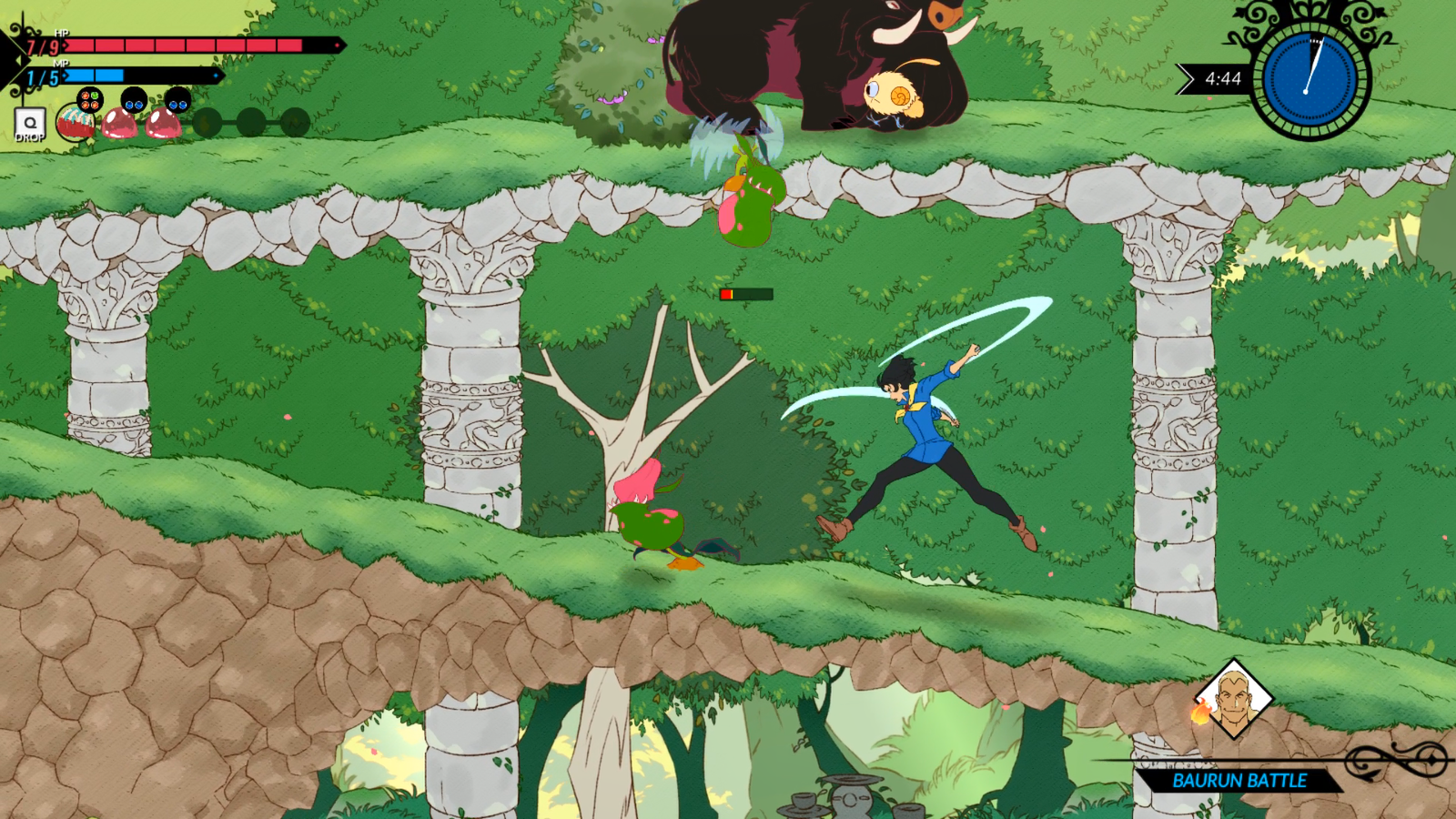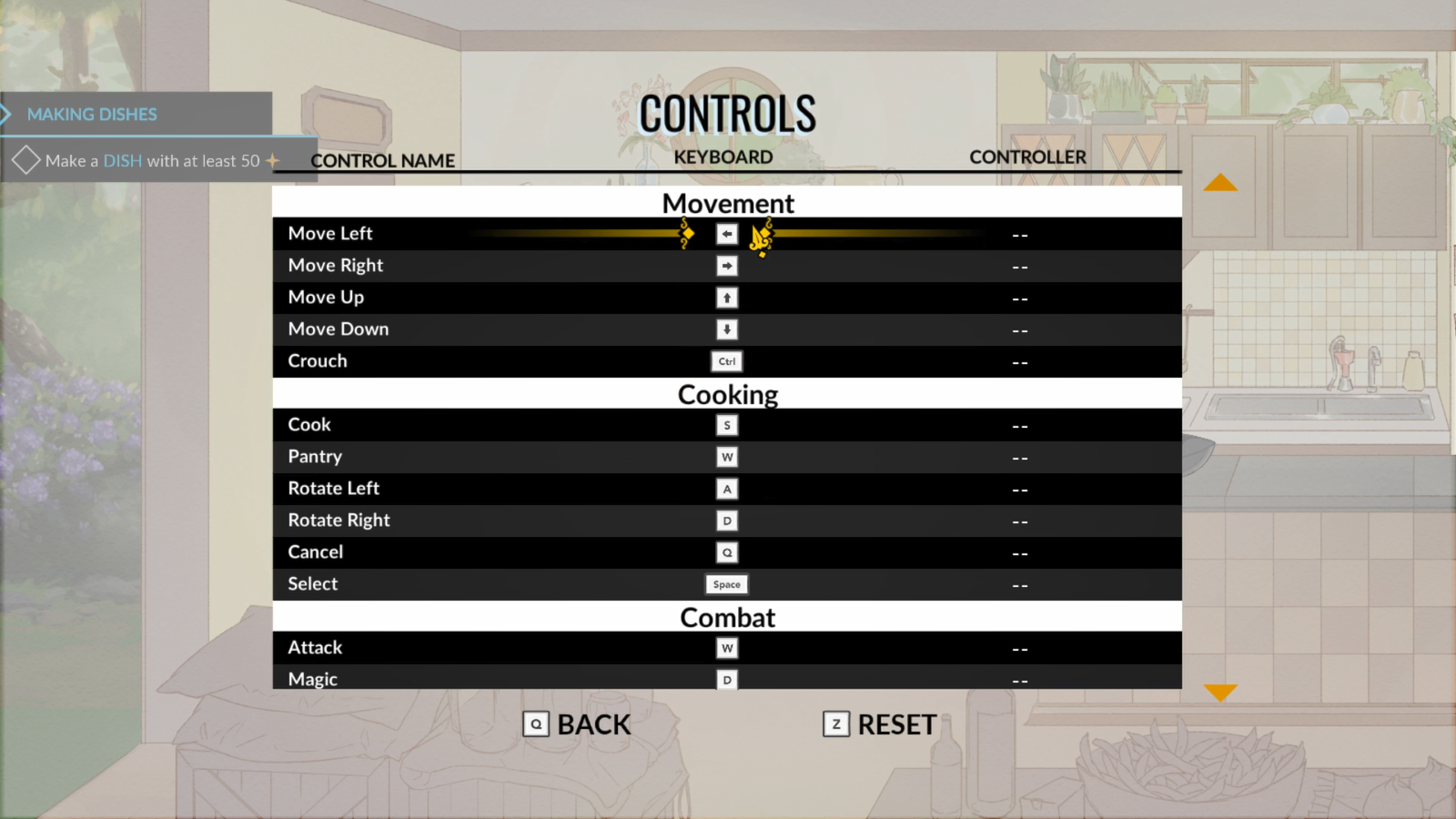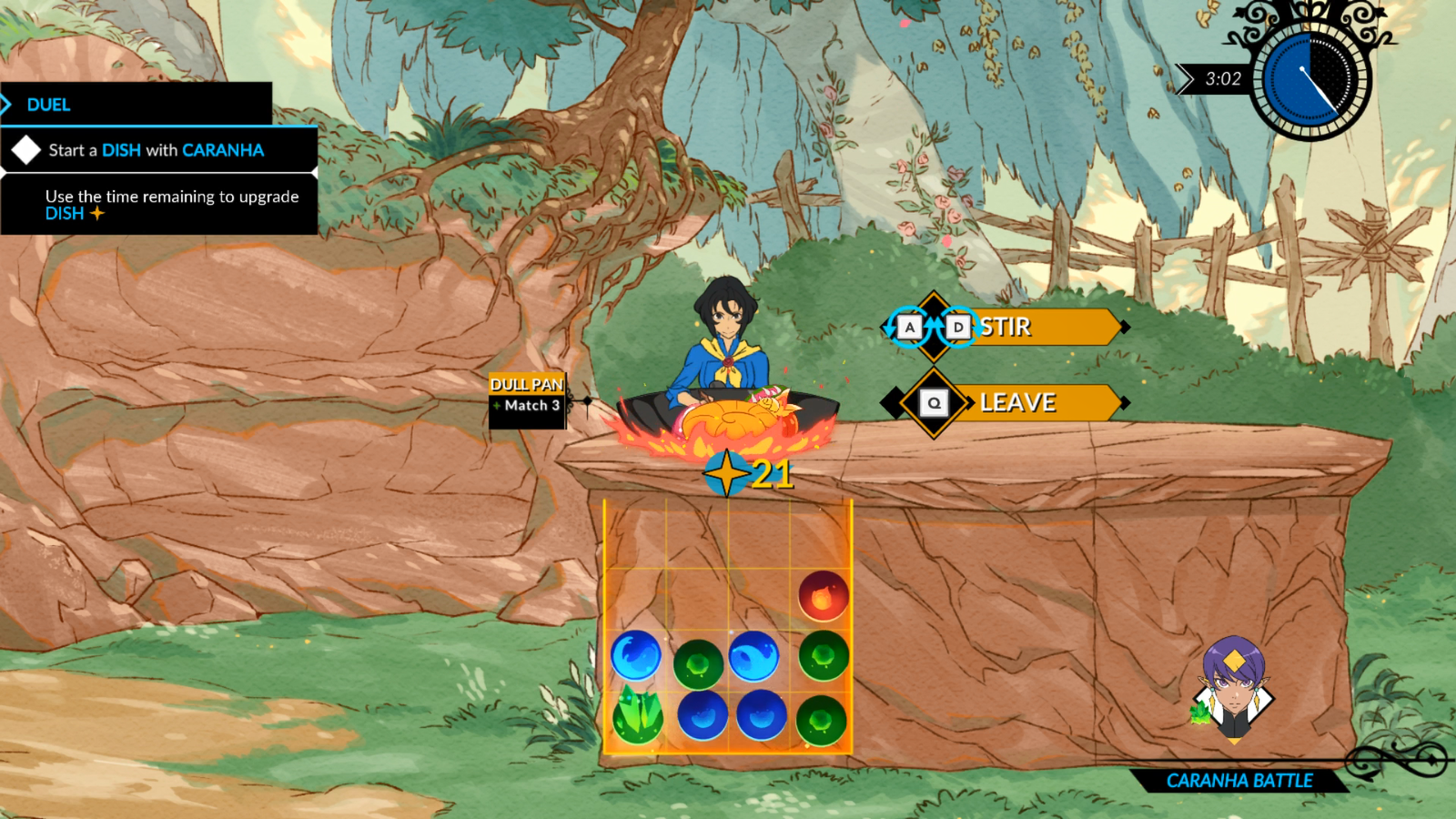Battle Chef Brigade is a game about odd combinations. Much like the gameplay, it’s all about mixing disparate elements to create a singular dish. It takes elements from games and even TV shows like Final Fantasy, Bejeweled, any visual novel, and even Iron Chef, and combines them in fresh and exciting ways. But just like the dishes you’ll craft in this bizarre tournament fighter, JRPG, cooking game, the final result is hit or miss.
Developer: Trinket Studios
Publisher: Adult Swim Games
Formats: Nintendo Switch, Sony PlayStation 4, PC [Reviewed]
Released: November 20, 2017 (Switch, PC), TBD (PlayStation 4)
Price: $19.99
Copy Provided by Publisher
The Making of a Brigade
Battle Chef Brigade is Trinket Studio’s third game, delivered to us by a fantastic Kickstarter campaign in 2014, which raised over $100,000. You can see why it raised so much, as the crowdfunding project was fantastically laid out – full of screenshots, gifs, videos, and information about the story and gameplay. It is also pleasingly representative of the final game.
There are three core elements that make up Battle Chef Brigade: the two gameplay aspects are a match-3 puzzler and 2D, side-scrolling combat. The third element is its story, which plays out in a pseudo-visual novel. These gameplay styles are nothing special on their own, but when combined, it makes for a unique and compelling experience.
To join the ranks of the Battle Chef Brigade, residents must compete in a reality TV cooking competition against other prospective members. Whoever scores the most points wins.
You play the role of Mina Han, a young woman still living with her parents helping to run the family restaurant. Rather than going to the shop to buy ingredients like any normal cook, every chef in the world of Battle Chef Brigade is expected to hunt their own plants and animals. But the twist is that every creature in this world is a deadly monster, so hunting isn’t as easy as just shooting Bambi – you’re expected to fight deadly creatures.
This is fleshed out in the world itself – the fantasy realm of Victusia. It’s basically your stock-standard anime, fantasy world, full of orcs, dwarves, cute animal companions, and overly dramatic characters. But what this adds is twofold. The first is that rather than the monsters being represented as some kind of terrible threat to humanity, the residents of this world instead treat them like we treat our animals. They’re just kinda there, and a good source of food, just more dangerous. It also gives us the premise (and title) of the game: The Battle Chef Brigade.
The BCB is Victusia’s military force, although instead of fighting other nations, they fight the monsters and keep people safe. But they’re also chef’s, serving up their kills in restaurants throughout the country or just supplying people with fresh ingredients. It’s an absurd premise, but it works because the game is so light-hearted, and because the developers chose to make the game more about food than an apocalypse. Don’t worry though, because it gets even more absurd, and fun.
To join the ranks of the Battle Chef Brigade, residents must compete in a reality TV cooking competition against other prospective members. Only the winners get to join, and that’s where the combat and puzzle elements come into play. During a battle, you must first head out into the world and kill monsters to get ingredients, then you have to cook those ingredients in the puzzle section to create dishes and please the judges. Whoever scores the most points wins the battle. If you lose three battles – which you can do – it’s game over, and you have to win six to advance to the final death gauntlet round.
A Puzzling Endeavor
The puzzle sections are where Battle Chef Brigade really shines. After you gather your ingredients, you’re given a plethora of options on how to prepare them. First, each battle has a theme ingredient that must be in the dish or you’ll lose a lot of points, as well as theme elements you must incorporate as well. There are three distinct elements that come from various monsters and plants: Fire, Wind, and Earth. You need to take your freshly gathered ingredients, and combine them via a match-3 puzzle game. Match three of the same elements together, and you’ll get more points, as well as a bigger, better element which you can also match three of to further increase its point value. If you’ve played any match 3 game before, this will all be very familiar to you.
There’s a great difficulty and progression curve in Battle Chef Brigade where it slowly introduces these elements to you one at a time so you have a chance to learn and practice how it all fits together.
It’s pretty simple at first, maybe too simply in the early going, but very quickly the difficulty will start to ramp up as new permutations are introduced. Early on you start running into enemies with bones in them, which can be a good thing as much as a hindrance. Match three of these together and you’ll get a rainbow piece, which will act as a free third piece for any elemental chain. Again, standard stuff for a puzzler. But, you also get access to a cutting board, which lets you remove bones or any other unwanted element from an ingredient. This gives you a tactical decision to make with every ingredient: “Do I remove the bone or gather three of this type of ingredient to get the rainbow piece which could increase my score?”
Then there’s poison, which will increase potency every time you spin that element. Once you spin it three times, it’ll crack all the elements touching it. Cracked elements will break if you move them three times, and they can also spawn on their own. Here, you’ll be introduced to the oven as well, one of which converts cracked elements into normal ones, at the cost of time. Other ovens can remove poison, or automatically increase the level of elements, though again at the cost of time. You’ve also got sauces, which can change the elements of selected ingredients, get different cooking apparatuses like frying pans that can give you different multipliers and bonuses, special items that’ll give you extra ingredients, and so on.
All of these items can be changed at any time before a battle. You’ve got a set load out which you can swap out for different cooking devices, different enhanced ingredients you can take with you (though a limited amount, of course), and different items for combat. Some of these are given to you if you beat an opponent, but you can also buy these items by completing tasks in town – an un-timed puzzle section that acts more as a tutorial, a matching mini-game, and a set of bog-standard combat challenges. You can also freely practice whenever you want. All this gives you an incredible degree of freedom and choice when it comes to how you want to approach battle. The game gives you just enough rope to hang yourself with, and backs off.
Iron Cuisine!
The real standout is the tournament itself. The game does a great job of making you feel like you’re in a real tournament. With a long intro before each battle straight out of Iron Chef, butterflies will start to form in your stomach. It seems like it takes forever, and you just want the judges to tell you what you need to do so you can play, but in a good way.
The anticipation mounts, and you start to see how serious this is, as a massive audience cheers you on, and you meet all these super important judges from across the whole world. You don’t want to screw up because you really feel like you’re auditioning for something important. If you win, there’s a great sense of joy and accomplishment, and excitement that you were able to win against a tough, highly revered opponent when you didn’t give yourself a chance. And if you lose, the pressure is massively increased on you, and you feel like you have no more room for error.
All of it sounds overwhelming at first, and it is, but it’s not nearly as complicated as it sounds. There’s a great difficulty and progression curve in Battle Chef Brigade where it slowly introduces these elements to you one at a time so you have a chance to learn and practice how it all fits together. It can get stressful in the heat of a real tournament battle, but that’s part of what makes them so great – you really do feel the pressure of having to manage everything effectively. Whenever a new element is introduced, it at first feels like it’s making the game too difficult, but as you practice and get used to it, they each become a welcome addition.
It’s just a shame that level of depth doesn’t extend to the rest of the game.
One Note, Played Perfectly
Despite the unique premise behind Victusia, Battle Chef Brigade seems either afraid or uninterested in doing anything with it. Beyond the tournament Mina enters in, the plot is a boilerplate “save the world from the baddies” narrative. The characters are also all two dimensional anime stereotypes, none of whom change or grow over the course of the game. The one exception is Mina, the protagonist, though it comes in the way you’d expect. She starts out as a carefree kid who wants to see the world and make a difference, but slowly she realizes how tough and cruel the world can be and grows up a little, realizing she’s had all she’s ever needed all along.
I could tell you that Thrash is the big lovable sidekick, or that Kirin is the smart bookworm, but that doesn’t do these characters nearly the justice they deserve.
Still, the premise alone is enough to grab you, and force an investment in this world. What holds that investment is the voice acting. The main story beats and some of the more prominent side stories are voiced, but the optional conversations with people in the streets are all done through text. The characters also emote through pre-drawn positions too. They’re not fully animated, instead cycling through different models throughout dialog, like in a visual novel.
That’s a good thing, because it lends an extra layer of believability to the characters. While dull on paper, the voice acting, body language, and the top-notch dialog all make the characters far more interesting then you’d think they would be. I could tell you that Thrash is the big lovable sidekick, or that Kirin is the smart bookworm, but that doesn’t do these characters nearly the justice they deserve. Together, they make the world feel like a living, breathing place, even if the narrative they’re trapped in doesn’t go anywhere.
There’s no getting around the fact that the plot doesn’t really work, and a lot of that has to do with how the combat works during tournaments. Now this is probably supposed to be covered under “suspension of disbelief,” but I can’t shake how terrible a system this is for recruiting people.
Uninspired Combat
See, combat is completely irrelevant to your score in the tournament, which makes you wonder what the point of it is to begin with. You’re judged entirely on your cooking, which means the Battle Chef Brigade is probably full of great chefs but mediocre soldiers. You’d think they’d be soldiers first, because the whole point of them is that they protect people from the monsters. So surely they should judge you on your fighting technique too, or at least how many monsters you kill, right? There’s a disconnect there, and the game tries to get around this with its humor and a light tone, but it’s a thought I couldn’t get out of my head, no matter how hard the game made me laugh.
It’s a dull grind and never evolves the same way the puzzle sections do, it’s the same at the end of the game as it is at the start.
Maybe that’s a good thing, however, as the combat is uninspired and despite being a core gameplay element, it feels tacked on. You’ve got basic melee and ranged attacks, dodges, uppercuts and ground pounds, but you can get by simply with a basic attack and a couple of dodges here and there. It’s a dull grind and never evolves the same way the puzzle sections do, it’s the same at the end of the game as it is at the start. You can get upgrades for the combat sections just like the puzzle stuff, but it never seems to make much difference, only giving you more health or mana, which was never necessary, as you never actually die in combat, you just get teleported back to the start of the combat area.
Speaking of incomplete features, there’s no online component either. There are daily challenges, but you only compete against an online leaderboard, never against a real human opponent at the same time, which feels like a huge missed opportunity. This would be the perfect kind of game for some kind of online versus mode, but such a thing just doesn’t exist.
Control Issues
Battle Chef Brigade hides its greatest opponent until you start to play it for yourself, however. It isn’t other chefs in the tournament, it isn’t the battle timer or judges, it’s not the puzzles or even the monsters. No, your real opponent is the terrible control scheme, at least on the PC version. It’s a constant fight, one you always feel like you’re deadlocked at best, and losing miserably at worst, which is most of the time.
Unfortunately any description of the controls can only go so far, it’s the kind of thing you have to experience yourself to truly understand. For a start, the mouse does nothing. It can operate menus, but it can’t be used in combat or general gameplay at all. And it doesn’t even fully work with menus, as the longer menus that need scrolling can’t be scrolled with the mouse, you have to use the arrow keys to move down the list.
These controls feel like they were created by someone who’s never played a PC game before. Movement is on the arrow keys, Q is select and back, W is attack in combat, but also opens the pantry in the puzzle mode. That’s the main problem: the controls for the combat and puzzle sections are radically different, and they’re both a confusing mess.
In puzzle mode, you start out by selecting what cooking device you’ll use, with each device also having its own control scheme. The cutting board, for example, uses S to start cutting, then you have to alternate pressing A and D to actually cut. When you’re done, you then have to press Space to pick it up and move it to the pan or oven. For those two, you have to align where you’re going to put the cut ingredients down, then you have to decide if you have to grab more ingredients from the pantry by pressing W, and start cooking with S. Or you can press Q twice to leave cooking and walk over to something else.
Once you start cooking, you have to use A and D to spin the elements around, the arrow keys to move the cursor, W to go back to the pantry, and Space to pick up the food and serve it. It doesn’t help that you can also press S again to stop cooking, which is literally pointless, and if your pantry is empty, W does nothing. So you’re constantly switching between different stations with different cooking instruments, each of them perform different functions and all of them have completely different control schemes, which also change based on contextual situations, like if you have food in your pantry or not.
I never once got used to these controls in my entire playthrough, losing battles even late in game simply because I wasted so much time sitting there fighting this control scheme.
Working your head around these controls is a puzzle in and of itself, and several times in the first few hours I had to stop cooking and accept the fact that I was going to have to serve crap just so I’d finish on time.
The controls suffer the most in combat though. Your main attack is on W, your special attack on D, dodge is A, Space is jump, the left and right arrow keys move Mina, and the up and down arrow keys are used to navigate horizontal planes. Words cannot adequately describe how unwieldy and difficult this is, especially when combined with the fact that you can randomly drop ingredients with Q and pick them up again with S. Double especially so when you can’t guide yourself while in the air, triple especially so when you have to press up AND jump to move to the platform above you or down and jump for a platform below you, and quadruple especially so when you have to land on the exact right pixel when jumping up to land on a platform, otherwise you’ll fall back down.
And remember, cooking comes right after combat, so just as you’ve wrapped your head around the combat controls you then have to throw that out and re-learn the cooking controls. I never once got used to these controls in my entire playthrough, losing battles even late in game simply because I wasted so much time sitting there fighting this control scheme.
I spent my first hour with the game trying to change the controls. This too is an ordeal on par with any of the game’s puzzles. You can’t change movement controls to WASD, because for some reason you can’t rebind the D key, so you can’t rebind the arrow keys either because then you couldn’t move left. For whatever reason, you can’t use the mouse buttons either. The controls would work a lot better if you could put attack on left mouse and your special ability on the right in combat, and then use them in the puzzle sections to spin elements left and right, but you can’t.
I tried to set up a controller too, but every time I alt-tabbed out of the game to take notes for this review, it would stop recognizing the controller and I would have to restart the game to get it to work again. Eventually the game stopped recognizing the controller entirely, and it still doesn’t. At that point I gave up, reset the controls to default (save for the changing attack and the special move to F and G), and gritted my teeth all the way through lest something else break.
I can’t help but think how much better the game would be without the combat, and was instead a visual novel with puzzle gameplay. Maybe there could be a “story mode,” option, where the player is given random ingredients instead. That would eliminate the tedious combat, and at least cut down on the control issues. But we have to look at the game we’re given, not what we wish it were.

Pros
- Unique premise, both in gameplay and the world
- Fantastic puzzle gameplay that perfectly introduces new, challenging elements
- Great acting and dialog bring characters to life
- Hand-drawn art style gives the game a stunning look
Cons
- Awful PC controls do their best to ruin the fun
- Combat elements aren’t fully realized, making a third of the game feel boring
- The plot doesn’t do anything interesting with its unique premise
- Despite the great acting and dialog, the characters are all standard anime stereotypes
Conclusion
Battle Chef Brigade is like riding a roller coaster. One minute you’re really high-up and having a blast, the next, you’re wishing you could play something else. The one constant throughout my time with the game is that it should be a lot better than it actually is. There’s a decent story here with good characters, great art as you can see, and great acting and dialog. But the lackluster combat, and the truly horrific controls hamper the experience. Those control issues may not be present on the Switch and eventual PS4 versions, but they’re there on PC, and that’s the version I played.
Ultimately, Battle Chef Brigade is a good game, though it’s the disappointing kind of “good.” Again, you feel like the game should be better than it is, and maybe with updates and patches it could one day be much better. But right now, it’s still a solid game.

